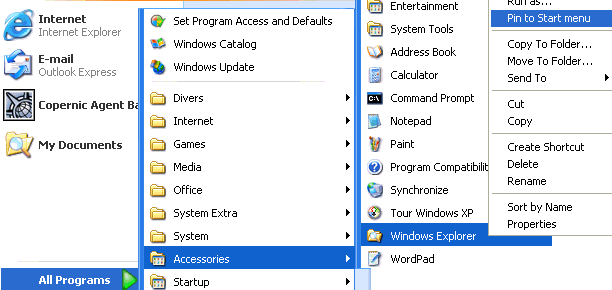
On the page about Windows modifications part II, there were already made some modifications introduced to the start menu (see Start, All Programs). At this page the start menu and the Quick Launch toolbar will be further refined. Now you have installed all your favorite software, you can make some modifications to the start menu and the Quick Launch toolbar in favor of a better overview. These modifications are badly needed, because the most installed software have their own policy of placing their own shortcut's. The consequence is a messed up start menu! The different folders in the start menu can be ordered alphabetical by right clicking on one of the folders and select Sort by name (this tip is also applicable to the Internet Explorer favorites).

Most times, the applications which you would like to use a lot are hidden while the applications which you sporadically use are everywhere! Fortunately it is easy to make changes to the start menu by means of dragging or copying shortcuts to another location (for example the desktop). Windows XP offers however the possibility to pin most used applications to the start menu, like below the Internet Explorer, Outlook Express and the folder My Documents has been pinned to the start menu. The pinning of a application to the start menu is very easy by right clicking on a shortcut and choosing to Pin to Start menu. Below is shown how one of the recent used applications (the internet search application Copernic Agent Basic) will be pinned to the start menu.
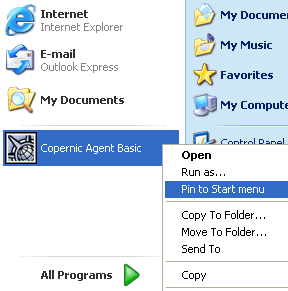
|
|
CHANGING THE DEFAULT WINDOWS EXPLORER FOLDERThe default folder which the Windows Explorer (part of All Programs\Accessories) opens, can be changed easily. For example to open the Windows Explorer by default in the folder D:\Data, you can change the properties of the Windows Explorer shortcut (right click on the Windows Explorer shortcut and select Properties) to: %SystemRoot%\explorer.exe /n, /e, D:\Data |
USING ANOTHER BROWSER AND MAIL PROGRAMAs in above start menu you can see that in the default Windows XP settings, Internet Explorer is the default browser and Outlook Express the default e-mail application. You can change the default browser and e-mail application by right clicking on the start menu button and select Properties, tab Start Menu, button Customize. There you can modify the standard e-mail application and Internet browser in your favorite browser and mail application. You must also check the settings of the Internet Explorer by Extra, Internet-options, tab Programs. |
However, the XP start menu isn't always the most optimum and pleasant way to start an application. Most times you have to click or do a mouse over three times before you can access your favorite software which is not pinned to the start menu (as described above). Of course you can use shortcuts on the desktop, but I favor a clean desktop. To make live more easy, you can use the Quick Launch toolbar. By default the Quick Launch toolbar is disabled, you can enable this toolbar by right clicking somewhere on the blue menu bar, select Toolbars and activate the Quick Launch toolbar, as shown below.
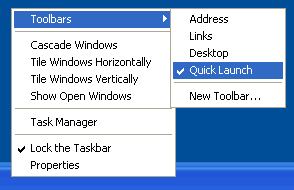
Now you will see the Quick Launch toolbar with a double arrow to the right, as shown below. By dragging shortcuts to the Quick Launch toolbar you can compose your own quick start menu. You can also delete shortcuts by right clicking on them.
![]()
We are not finished yet! You can rearrange the shortcuts in a logical manner, as shown below. Here you have seven sub folders named System, System Extra, Games, Office, Media, Internet and Divers. If you would like to make those folders, you can create them in the folder C:\Documents and Settings\your account name\Application Data\Microsoft\Internet Explorer\Quick Launch by using the Windows Explorer. Remember not to make sub-sub folders in the Quick Launch toolbar, this can go wrong because of the used file system!
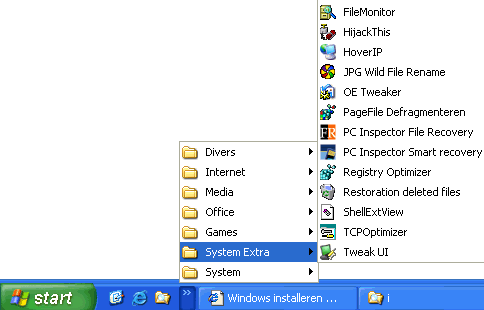
Instead of using the Start Menu, you can now click the double arrow, and the new menu appears, one click less...... This way you can make each application within reach! In above example one of the sub folders is shown, as you can see a lot of important shortcuts concerning system enhancements have been placed there. If needed you can drag and drop folders from the Start Menu to the Quick Launch menu.
REMOVING THE LANGUAGE BARYou can use the Language Bar (shown on the right of the taskbar), to switch keyboard layout (if you have more than one defined...). You can do this easily by pressing the left ALT and the right SHIFT at the same time. This can happen unintentionally, which can be irritating if you don't understand what happened (a restart of Windows always fixes that problem.....). If you don't need the Language Bar, you can hide it in the following manner: Start, Control Panel, Regional and Language Options, tab Languages, button Details, button Language Bar on the tab Settings. If you don't need to switch between keyboard layout, you can delete the unused services (not bold items) on the earlier-mentioned tab Settings, the Language Bar will disappear automatically. |
You can change the items (and add folders) in the Start Menu and Quick Launch by editing the following folders in the Windows Explorer:
C:\Documents and Settings\All Users\Menu Start
and
C:\Documents and Settings\your account name\Menu Start
C:\Documents and Settings\your account name\Application Data\Microsoft\Internet Explorer\Quick Launch
Some tips: with the key combinations CTRL-X , CTRL-C and CTRL-V you cut, copy and paste shortcuts and folders (for example you can move (CTRL-X) or copy (CTRL-C) the folder Games in the Start Menu to the Quick Launch menu (CTRL-V)). By clicking File, New, Folder you can make extra folders.
YOUR OWN DOCUMENTS TOOLBARYou can make your own extra toolbar by right clicking on the blue area of the Start Menu and choosing Toolbars, New Toolbar... For example, you can make a shortcut to the My Documents folder (or a sub-folder), to have fast access to your own documents! The new toolbars will appear on the right side of the menu bar. |
There are still items to optimize! On the right you see the icons of the system tray, the active applications working in the background. Most of the applications you won't even use, and some are important to show (firewall, virus scan, internet connection) or to have fast access to. It is very easy to hide the unused icons of the system tray: right click the blue area of the Start Menu and select Properties, button Customize (if needed, check the Hide inactive icons box). Here you can change the notifications behavior of the system tray icons. Now you will see the following screen:
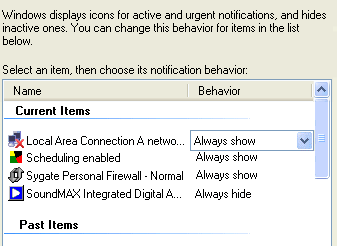
Select which items you would like to see and which you would like to hide permanently. By hiding items they will disappear behind the '<'-sign. By clicking this arrow they are quickly accessible.
![]()
DELETING ITEMS FROM THE STARTUP FOLDERMake sure that there are no unnecessary application shortcuts in the Startup folder (Start, All Programs). Applications which are mentioned in this folder will start automatically with a restart of Windows. Some examples are the MS Office icon and some 'registration remembering' icons. They slow down the startup of your Windows, and use a part of your system memory. They can be removed by deleting them or to drag and drop to another part of the Start Menu! |
REMOVING YOUR NAME FROM THE START MENUWould you like to remove your name from the Start Menu because you have multiple users with the same account, you can choose to hide it. This is possible in the Windows registry, by adding a new DWORD named NoUserNameInStartMenu with the value 1 into the key HKEY_CURRENT_USER\Software\Microsoft \ Windows\CurrentVersion \ Policies\Explorer and your name will disappear from the Start Menu. |
FASTER START MENUWould you like a faster appearing Start menu? You can do this by editing the Windows registry: go to the key HKEY_CURRENT_USER\Control Panel\Desktop and modify the value of MenuShowDelay in 100 (for example). |
USING TWEAKUI FOR CHANGING THE START MENUWith the Microsoft application TWEAKUI you can make more changes to the Start Menu. For example, it is possible to delete the items Log Off and Help and Support (also accessible with the F1 key). |
© 2001-2022 - Menno Schoone - SchoonePC - Rotterdam - The Netherlands